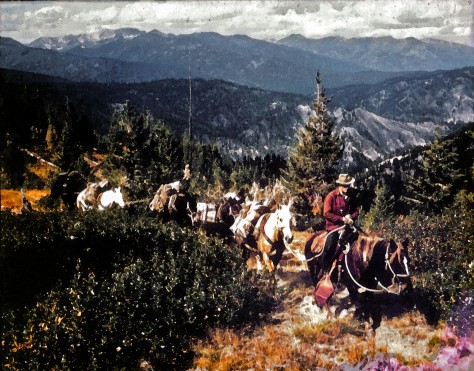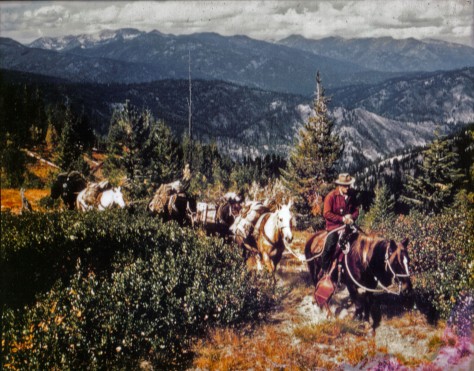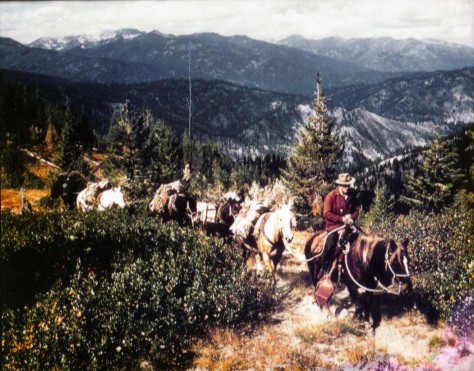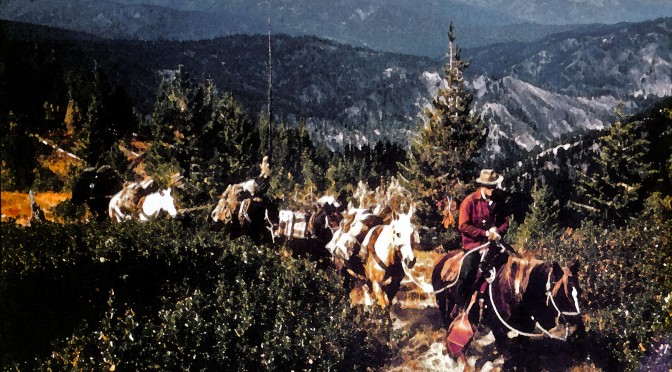

My step dad, Filbur (Phil) Lakey, composed this photo in about 1949, probably with a Brownie camera while on horseback. This is his step dad, Ken Thomas. Ken was the Ranger at Krassel Guard Station near Yellow Pine, Idaho, for about 30 years and Phil often worked trail crew with him, packing into the back country with a string of mules. Common cameras in those days had a view finder on top; the photographer aimed the lens at the subject and looked down on a big square glass to frame the picture. The subject was upside down in the viewfinder. Imagine doing that on a horse on a rugged mountain trail. In those days the film was black and white so I might have the year wrong or this photo might have been retouched to color it. Look at the lower right corner where age is changing the hue and let’s believe this image was made with color film.
Today’s photo assignment for https://photo101march2015.wordpress.com/ is Landscape. Instead of shooting a new scene, I came back to this old image to see yet again what I can make of it with tools in Adobe Photoshop CS4. You can see the changes from the first adjustment below, to the one above, and finally adding a watercolor filter to get the effect in the image at top. I scanned the image from the original enlargement which had aged over the years since it was first printed from the negative. Below you see how it looked after adjusting just tone, contrast, and color in CS4. In the image above I adjusted again, this time for shadows and highlights. The most noticeable change is the sky. Clouds now appear and the sky is more interesting.

The foreground is colored but the mountains in the background look like they have been made (or left) black and white. It could be snow because you can see fall hues in the foreground. Snow falls early in the high elevations. Look more closely. An enormous wildfire has swept through the wilderness and left the burned landscape colorless. With a little research I can uncover the date this photo was made.
I aspire to reproduce this image with Prisma colored pencils or acrylic paint. I know I can do more adjustments in CS4 to bring out details in the white horses and correct the hue in the lower right corner. The left side background is darkened by a cloud masking the sun. I think Phil made a pretty good photograph with the equipment he had and being on a horse. He would have been up the trail and no doubt he was also leading a string of mules or horses. I can’t make out the structure behind the last white horse but I believe it’s another horse, a dark one, with a big pack stacked on it. Mule strings could be long and often a mix of mules and horses among the pack animals.
Krassel Ranger Station is now a Forest Service Work Station in Payette National Forest, with headquarters in McCall, Idaho. The ranger’s cabin is available for temporary summer stay with the expectation the guests serve as host and docent to visitors. It’s located on the South Fork of the Salmon River, near Johnson Creek and Big Creek, and the so so small town of Yellow Pine, all part of the Salmon River in Idaho, adjacent to designated wilderness area. Once called the River of No Return Wilderness, it is now termed the Frank Church Wilderness. Here is a link for information about http://www.fs.usda.gov/detail/scnf/specialplaces/?cid=stelprdb5360033 and here is a link for a DVD that features this wilderness http://www.pbs.org/wnet/nature/river-of-no-return-introduction/7618/. I’ve seen it on live streaming from the PBS channel. Here is a link to photos and information about the Krassel Ranger District http://www.fs.usda.gov/wps/portal/fsinternet/!ut/p/c5/04_SB8K8xLLM9MSSzPy8xBz9CP0os3gDfxMDT8MwRydLA1cj72BTQxNjAwgAykeaxRtBeY4WBv4eHmF-YT4GMHkidBvgAI601R0O8it-t4NNwG2-n0d-bqp-pH6UOYY9Zk5mMFMic1LTE5Mr9QtyQ0MjDLJMQh0VFQFx4Y7u/dl3/d3/L0lJSklna2tra0EhIS9JTmpBQU15QUJFUkNKS28hLzRGR2dzbzBWdnphOTJBZyEvN18wTzQwSTFWQUI5MEUyS1M1NkI2MDAwMDAwMC9zYS5GU005XzAzMzMyOA!!/?pname=Forest%20Service%20-%20Krassel%20Work%20Center%20-%20Krassel&recid=&counter=null.0&actid=&navtype=BROWSEBYSUBJECT&ttype=photogallery&navid=091000000000000&cid=1491&pnavid=null&ss=110412.
I have a few photo albums of my family’s life at the ranger station over 30 years and those images are in black and white. Today’s post is about photography and adjusting old images but in a future post I will feature the history of the family that lived at the station and the ranger’s job, with vintage photos.

Oh, this is an amazing account of your touch-up process as well as the story you have to tell about your step dad working at the Krassel Guard Station near Yellow Pine, Idaho. What a wealth of information and history you have packed into this Photo Assignment. What quality of work and writing you have displayed. I am very impressed!
LikeLiked by 1 person
Ah, shucks. Thanks a lot. Your feedback means a lot to me. I love writing and photography and history. I really do need to spend some time getting the old photos and history recorded. My step dad’s sister was born when the family lived at the ranger station and she spent every summer there all through high school. She could tell me a lot. She’s only a year older than me, 17 years older than my step dad, and there is another brother between them who could tell me more. I’m on it but it will take some time.
LikeLiked by 1 person
I know. It seems it takes awhile to figure out the direction we are going, setting priorities and letting the “fluff” go. Seems I end up putting so much of my time into things that don’t really matter and the things I want to do, I have to carve out a space for them. Trying to get rid of those time wasters so I can get on with what matters to me.
LikeLiked by 1 person
Nice choice. Would be interesting to see how the photo looks using and app such as Snapseed. Would probably bring out the sky and mountains in a whole new way. Well done.
LikeLiked by 1 person
That is amazing love the photo and the history.
LikeLiked by 1 person
Thanks. It feels good to have this history in my people.
LikeLiked by 1 person
well done and an interesting story with it!
LikeLiked by 1 person
Thanks a lot!
LikeLike
I really enjoyed reading your post. Not only for the amazing work done to the photo but also for the story behind it. Thanks for sharing.
LikeLiked by 1 person
Thanks! I could tell a lot more about the ranger life as it used to be, but that would take time and more suitable for other posts.
LikeLiked by 1 person
You’re welcome. Please do another time. It’s very enticing.
LikeLiked by 1 person
A fantastic photo and a fantastic story! Color photography has existed from the 1800s and at the end of the 1930 and the beginning of the 1940s it also became possible to take still photographs with color films. But the black and white film was more common as it was cheaper. I tried to look at the picture and I think the colorisation is too detailed for it to have been a black and white picture that has been painted. For example there are several colors in the trees and that would have been very expensive to let someone paint color into the picture in this way. Another clue is if it is matte or glossy paper in the picture. Colorised pictures were matte so one could paint on it.
So I think it is an original color photography. The greyness of the mountains can be because of the distance to the mountains and also the sensitivy of the film. There is also aging of the picture that changes the color of the physical picture. So it is good to have scanned it. Then you can reproduce it when and if it fades.
Thank you for sharing this faboulous photo. I wish you a good sunday!
LikeLiked by 1 person
Thanks for your detailed look at the photo. I have painted photos by hand iand it’s a lot of fun and focus. I agree it was probably color film. The black & white mountians are definitely from an extrememly huge wildfire. The ruggedness of the terrain made it too hard to fight the fire in those days. Later the Forest Service developed a theory and practice of “Let it burn, it’s natural.” That’s a topic of another blog post.
LikeLiked by 2 people